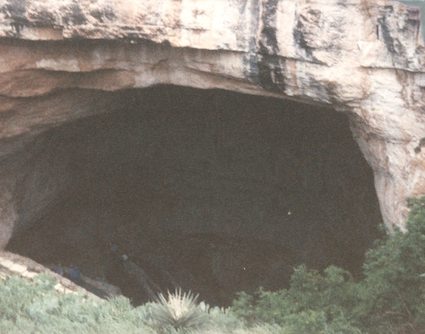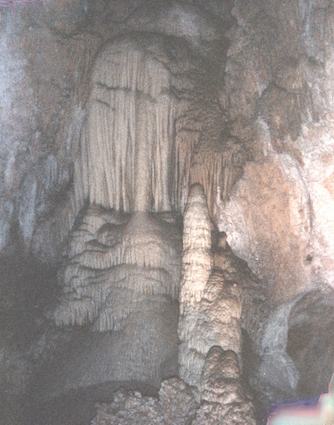Carlsbad, Eddy Co., New Mexico, USA (May 1992)

We drove up and over the Guadalupe Mountains in Texas, crossing into New Mexico and heading towards Carlsbad Caverns National Park in the southern part of the state (map). This is an unusual environment for a variety of reasons. The Guadalupe range is the exposed portion of an ancient reef that once graced an ancient sea, now pushed up above the surrounding terrain. Caverns abound, not carved by water as typical in most places but rather by corrosive sulfuric acid.
It also marks the northern limits of the Chihuahuan Desert, a small portion of which has been protected in perpetuity within the boundaries of the park. This is the same desert that we’d been traveling through all day since we left Big Bend.
The drive through the mountains almost ended our journey when the RV suddenly died. We’d pushed it too hard. We waited awhile, hoped we hadn’t damaged it, and tried again. Thankfully it started right up and we’d learned a valuable lesson about taking it easier through the mountains for the remainder of the trip. The mountains would get much trickier further west but we’d have no further problems.
We approached the caverns entrance, staring down the precipice into a gaping gash in the rocky terrain. The photograph barely does it justice. People down below appeared as mere specks. We had the option of hiking down the Natural Entrance trail into the cave or taking an elevator directly to a chamber 750 feet below the surface. Naturally we chose to hike and were amply rewarded along a steeply descending path stretching more than a mile along multiple switchbacks. We passed impressive features such Bat Cave, Devil’s Spring, Green Lake, the Boneyard and Iceberg Rock.
Stalactites, Stalagmites and Thousands of Bats

Once deeply embedded within the depths of the earth, we entered the main attraction, a chamber known as the Big Room. It is named appropriately with its very impressive dimensions: 4,000 feet long, 625 feet wide and up to 350 high. That’s a space of more than eight acres. It’s reputedly the 7th largest cave chamber in the world and I wouldn’t doubt it for a minute. We took the self-guided tour around the perimeter and experienced another set of astounding formations such as Bottomless Pit, Painted Grotto, Giant Dome and Rock of Ages.
The fun didn’t end after the underground tour. We ambled over to the amphitheater along the natural entrance as dusk began to creep across the desert. The park ranger led a presentation for attendees. He was a trained naturalist and we were there to hear about the bats. Huge colonies of bats live in the many caverns of New Mexico’s Chihuahuan Desert.
It is estimated that several hundred thousand Mexican Free-tailed bats live within the confines of Carlsbad Caverns itself. It’s a medium-sized species as far as that goes and they have a dark brown fur. They begin to awaken and leave their daytime habitats, the caves, as the sun dips below the horizon. They will feed all night.
Imagine the sight of hundreds of thousands of bats jostling to exit a cave at nearly the same time. In fact that’s how the caverns were discovered. It looks like a living vortex or almost a tornado emanating from the earth in an impressive, sustained display. For a more superstitious people it would almost seem like the the gates of hell had cracked open.

Leave a Reply